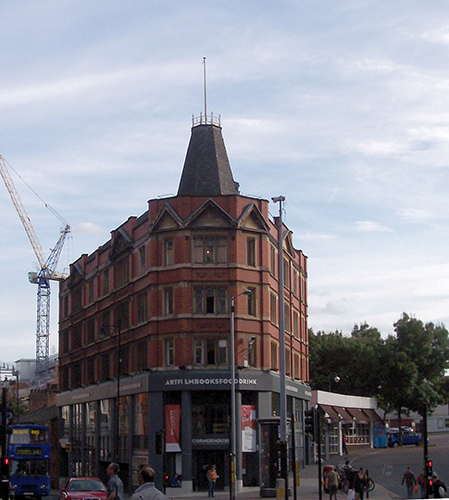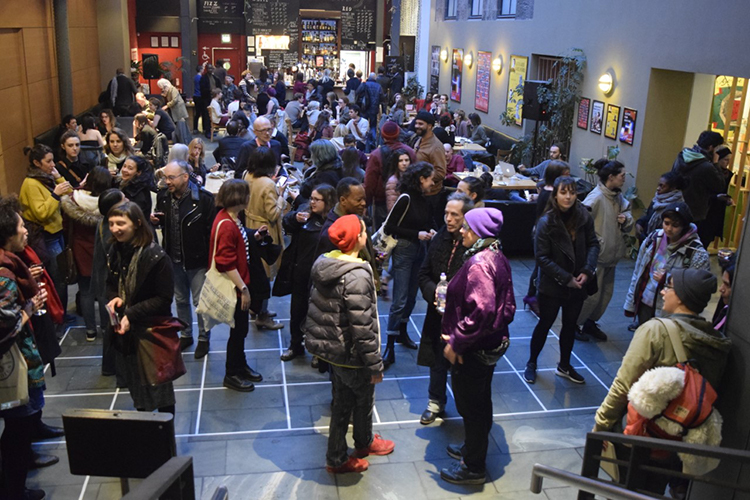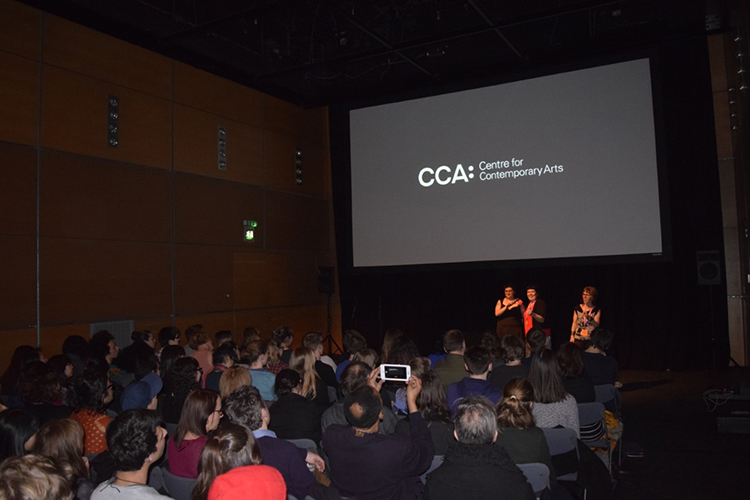Where we are now calls for a reinvention of the way we approach cinemas as a business and cinema as a community asset. In this blog series, we ask people to share a personal vision of what’s not working now and what the future of film exhibition should look like.
In this fifth article we hear from Dr Leanne Dawson, Senior Lecturer in Film Studies at the University of Edinburgh, about the ways in which cinemas and film festivals can be more accessible and welcoming for people who are working-class and/or in poverty.
As a student, I borrowed and devoured nouvelle vague films alone in front of a DVD player, rather than watching them when they were screened – often in conjunction with courses I studied as part of my degree – at the local independent cinema.
Why? Because independent cinemas did not feel like a welcoming space for me, someone born into poverty, and often made to feel as if I lacked the correct way of speaking, the right cultural knowledge, and the behavioural norms of my middle-class peers to appropriate such a space.
Now, as a Senior Lecturer in Film Studies, I work with cinemas and festivals in various capacities and feel much more at home in them, but have friends and family for whom such spaces are not simply not welcoming, but actively hostile.
This must change: independent cinemas, film festivals, and so on must be more mindful of working-class audiences and colleagues.
COVID-19’s significant increase in online culture, with people only able to watch film at home alone or in small household bubbles during lockdown, rather than communally, surely signals a time for cinemas to think more about both audience access and staff access.
This blog post clearly outlines inclusion measures so that any organisation, group, or individual that screens film can make it more accessible for people who are working-class and/or in poverty. I also consider the digital divide and argue for a blended model of accessible on- and offline events in future.

Low budget film festivals and accessibility
Some organisations work hard to ensure strands of access: smaller low/no budget queer film festivals, for example, often aim for a high level of inclusion for people with disabilities and people who are D/deaf. This is a key aim of the Scottish Queer International Film Festival, of which I was Chair, which stands on the shoulders of other activists and festivals such as Wotever DIY Film Festival (London), Leeds Queer Film Festival, and GLITCH QTIBIPoC Film Festival (Glasgow).
These festivals demonstrate that access and inclusion do not always require a large budget, but rather care and consideration, meaning that many more places and people involved in film exhibition could have a larger, broader audience if they were willing to make changes to make them welcome.
So, how can we learn from this to increase the involvement of people who are working-class and in poverty?
How to make film events more accessible
While financial accessibility is significant, being working-class and/or in poverty is not just about money. It is also about being excluded and made to feel like we do not belong in a certain space or as part of some event formats, and about the ways we are represented, or not, on- and offscreen.
In order to improve working-class inclusion, middle-class+ people – and the film industry overwhelmingly comprises people who are white and wealthy – need to stop imposing what they think people who are working-class and/or in poverty need and, often, getting it wrong and alienating audiences.
Instead, working-class people must have the opportunity to employ knowledge and experience in film exhibition and curation, in more than a tokenistic capacity.
If you need a more selfish reason for hiring us: listening to working-class people would be better for business!

Access and inclusion measures for people who are working-class and/or in poverty
- a spectrum of working-class representation onscreen at a venue, rather than simply tired stereotypes and tokens;
- a wide range of work by, and support for, working-class filmmaking teams (who often have less film/education, equipment, and fewer networks etc.);
- working-class filmmaking teams present at events such as Q&As about their work, with accommodation, fares, sustenance etc. paid;
- more transparent and fair staff recruitment, reaching beyond existing nepotistic and arts networks, and including those with no experience, allowing them to train/gain new skills and knowledge on the job;
- transparency about who receives payment, ensuring working-class people are remunerated and that BIPoC (Black, Indigenous, and People of Colour), people with disabilities, and so on are not expected to give their knowledge and time for free in the name of Equality, Diversity, and Inclusion (EDI);
- career development for all staff at the cinema or exhibition space, including a fair and transparent allocation of other ‘perks’ and opportunities to network, travel etc.;
- working-class audience members made to feel welcome and included by all members of the team;
- offering free and sliding scale tickets without requiring proof/anything that identifies the ticket as not full price (this also applies to screenings running in conjunction with university courses. Working-class students should not have to pay for cinema tickets to access films screened in local independent cinemas as part of their course);
- a welcoming events space;
- reasonably priced refreshments, including cheap nutritious food that can be enjoyed by children, and free alternatives available/an agreement that people can consume items they bring with them so that pre- and post-film socialising at the venue is not limited to those with sufficient money;
- well-timed events so that people can take public transport home, rather than significantly more expensive taxis;
- a consideration of the style of events, e.g. the post-screening wine reception where middle-class people feel more confident in the space because they have the ‘right’ accent, where they opine loudly with some cultural capital and knowledge or simply because they feel more able to blag it. These feel very outdated and often exclude not only working-class people but also some with disabilities or with accompanying children.

Experiences and intersections
‘Working-class’ groups many different experiences together including those of us raised working-class but now with significantly more cultural and financial privilege. Furthermore, growing up in an inner city council high rise is very different to a rural childhood in poverty and we also need to consider intersectionality, and be aware that being BIPoC or having a disability, for example, makes poverty more likely because of systemic racism and ableism.
Organisations need to consider these intersections when working on access, inclusion, and representation, onscreen and off, and this is a reason why one token working-class person on a team is insufficient.
Working-class parents and children
It is also important to think about parents and carers: women do a disproportionate amount of childcare and domestic labour and having childcare in place is often bound to socio-economic privilege and the finances to pay a nanny/childminder/babysitter/nursery. For some, this is prohibitive to working, nevermind being able to watch a film at a cinema without their children present.
Working-class women deserve better!
To be truly accessible is to consider options for all children as well as childcare.
This helps working-class families and families in poverty two-fold: by ensuring parents and carers have some time to enjoy culture for themselves beyond the home, and to give children in more deprived situations access to a wide range of age-appropriate film, which not only entertains but also shows them that cultural spaces and events like independent cinemas and festivals are for them, now and in the future.

Home and away: A blended model for an accessible and inclusive future
Some may suggest that watching from home is an easier answer for those with young children as well as people in poverty.
Indeed during lockdown, Sky Store Premier showed family films for around £16, when unable to premiere them in closed cinemas. Although expensive, and prohibitive to people in poverty, this is cheaper than cinema tickets for a family, transport to the venue, snacks etc.
But we need to consider that watching in the living room is a very different experience to a trip to the cinema, that not every home is a safe space (think: domestic violence, homophobia, child abuse etc.), and that not every home has internet access.
The digital divide is real and that which some of us consider more accessible, as culture comes directly into our homes, is not at all accessible for those without the devices, or internet access to consume it.
While it is important to offer a broad range of digital events post-pandemic, it is equally vital to ensure that a new hierarchy is not created: at the top, those present, socialising and networking; followed by those watching from home, isolated behind a screen (possibly a greater proportion of people with disabilities, people who cannot afford to travel to the festival, those with parenting responsibilities etc.); and, left behind, those who are unable to access either the physical screening space or the film online.
There are clearly pros and cons for both in-person events and digital ones, with neither being a solution to accessibility and inclusion for all people.
Film events should be available simultaneously to those at home via streaming, allowing greater numbers of participants, who can access a broader range of culture.
Indeed some might feel more confident to be introduced to a wider range of arts and events this way, but we cannot leave others behind.
A new classist and ableist divide is highly likely if dual modes of delivery are adopted with the digital event considered the accessible option so that measures do not need to be put in place for the in-person event, which could result in EDI measures excluding rather than including.
Access and inclusion have been turned into a feminist issue, and a queer issue, and a disability issue, and a working-class issue, and a person of colour issue because doors are, after all, always open for able-bodied, wealthy white men, but access and inclusion are everybody’s issue because every body should be catered to.
It is for those of us working in film exhibition to show we are fully accessible and inclusive, which is not only the right thing to do, but putting more bums on seats by widening the audience and the market could ultimately help to save some vulnerable screening spaces in the post-lockdown future.
For a more in depth consideration of the inclusion of working-class people and people in poverty, alongside people with disabilities, and parents and carers, see my article, ‘Culture in Crisis: A Guide to Access, Equality, Diversity, and Inclusion in Festivals, Arts, and Culture’ here.
Dr Leanne Dawson is Senior Lecturer in Film Studies at the University of Edinburgh. Her publications include books, Queering German Culture (2018) and Queer European Cinema (2017); special journal issues including Queer/ing Film Festivals (with Skadi Loist, 2018) and The Other: Gender, Sexuality and Ethnicity in European Cinema and Beyond (2014); and she has written numerous chapters and articles on LGBTQI+ and working-class representation in film and the arts.
She works with a number of film festivals and cinemas in various capacities: she was the first Chair of the Scottish Queer International Film Festival; she is collaborating with LGBTIQ+ film festivals to improve working-class inclusion; she mentors young people in film curation; she is invited to international film festival juries; and has created, curated and hosted dozens of events for cinemas and arts venues.
Please do get in touch with her if you would like to speak more and/or collaborate on better access and inclusion for working-class people, people in poverty, parents and carers at your organisation.
Twitter: @Dr_LeanneDawson
To read the first article in the series by Rebecca del Tufo about a more inclusive future cinema, click here. To read the second article in the series by Megan Mitchell about a vision of revitalised programming and pricing, click here. To read the third article in the series by So Mayer about their vision of a sector which values caring labour, click here. To read the fourth article in the series by Charlotte Little about her vision of an industry which accommodates D/deaf audiences, click here.

